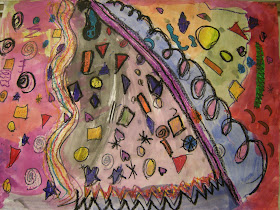George
Rodrigue is a Louisiana native and has been painting for 40 years. He started painting at the age of 5. His inspiration for painting Blue Dog came
from a story his mom read him about a werewolf, that werewolf reminded him of a
dog, and then he wanted to paint the dog blue.
We read the book, Why Is Blue Dog Blue and students learned that
Rodrigue did not always paint Blue Dog blue.
On the day he went fishing he painted Blue Dog salmon; when he ate a hot
dog he painted Blue Dog mustard; when he went to the beach painted Blue Dog
tan. So the places and objects that
Rodigue experienced influenced his color choices for his art. Rodrigue’s advice to students is, “Paint what
you like.” Students were able to draw a
Blue Dog and paint Blue Dog any color they wanted and had to complete the
sentence: “I painted Blue Dog _______ because________.” Once students chose their color they had to
outline their blue dog with the complementary color (color opposite on the
color wheel) to make their do pop out.
Students learned what VALUE is and why artists use VALUE. Students used oil crayons to add value to
their dog. Finally students choose a
pattern using lines or shapes and a crayon resist technique to paint their
background.
Check out what the students in Mrs. VandenBush's classroom are doing in art! Some of th lesson ideas I come up with, but many of these ideas come from other wonderful art teachers!
Monday, February 18, 2013
2nd Grade Clay Owls
The
2nd Grade students learned about and experimented with clay. Students learned that clay is a material that
comes from the earth and can be either white or terra cotta. Students first had to wedge their clay to get
all the air bubbles out. Next they had
to create a pinch pot for the base of their owl. Students learned how to attach clay pieces by
using slip (glue for clay) and scoring (scratching the clay). Students were able to use various tools to
add texture to their owls. Students were
able color their owls in an abstract way to create a very fun clay owl. Students also learned about the firing
process of clay and were able to view the kiln.
Finally students were able to view some videos to learn some important
facts about owls.
2nd Grade Cats
Laurel
Burch is a self-taught American Folk
Artist. Folk Art is artwork created by common people who have not had
formal training in art, usually reflecting their traditional culture or
everyday live. Laurel Burch had a rare
bone disease that her bones would break very easily. Sometimes she was in the hospital for months
at a time. Laurel was always incredibly
creative. Even during her long periods of recovery when she was forced to paint
from a bed or wheelchair, she seldom put her brushes down. Laurel said, “I
refuse to have anything in my life that I can’t turn around into something
magical and beautiful. I just refuse.”
Laurel love for cats showed in her art.
She painted many different cats with abstract colors and patterns.
Laurel’s colorful cats were made into T-Shirts, purses, pins, jewelry. She also
loved to make jewelry. Her jewelry today
is known all over the world.
1st Grade Clay Coil Hearts
The first
grade students learned about the artist Jim Dine through a power
point. They learned that he is a living
artist who was born in Ohio, but now lives in Europe. We talked about symbols and how people
all over the world recognize what a heart is.
We looked at different examples of Jim Dine’s work with hearts in
them. Students learned about the clay
process and were able to create a heart slab and attached coils to fill their
heart. Students also learned about the
clay firing process and were able to see the kiln. Students used a crayon
resist technique to color their clay to replicate the style of Jim Dine’s
artwork.
























